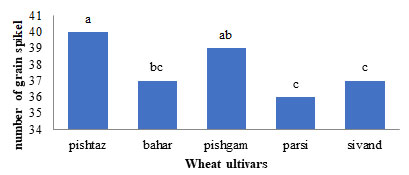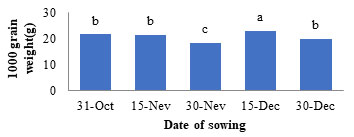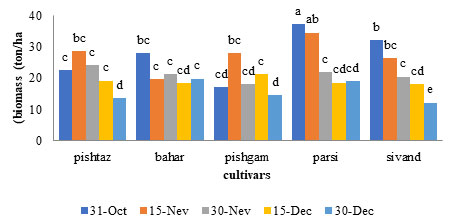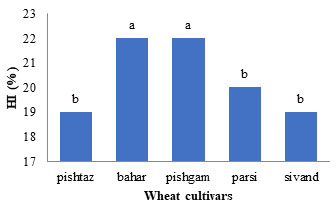Agriculture and Plant Breeding, Mazandaran, Iran.
Corresponding author email: Masoud_rad0000000@yahoo.com
Article Publishing History
Received: 12/03/2021
Accepted After Revision: 15/06/2021
A research was taken place to examine the impact of planting timelines on growth and the makings of harvested grains of various wheat cultivars in Iran. The examination was organized in Randomized Complete Block Design (RCBD) with a split-plot arrangement comprising of three replicas in December 2011 in Boroujerd, Iran. Five planting timelines (i.e. October 31, November 15 and 30, December 15 and 30) were observed in main plots, while five wheat cultivars (Pishgam, Parsi, Bahar, Sivand, and Pishtaz) were cultivated in subplots. The findings of this study indicate that the impact of planting timeline was highly pronounced within all of the factors with the exception of HI. The impact of cultivars was especially observed within all factors with the exception of the weight of 1000 grain. The highest number of grains per spikelet was observed with regard to Pishtaz cultivar.
Nonetheless, the highest number of HI was observed in Pishgam and Bahar cultivars. Parsi cultivar exhibited the highest rate of grain produce (10.23 ton/ha) and the Pishtaz cultivar exhibited the least multitude of grain produce (8.59 ton/ha). The highest rate of grain produces when it comes to planting timeline (10.15 ton/ha) November 15th and the least multitude of grain produce (6.1 ton/ha) was observed on December 30th. The Parsi cultivar exhibited the highest rate of grain produce when it comes to planting timelines but Pishgam cultivar exhibited a better growth rate when it was sowed on November 15th and Bahar cultivar exhibited a better growth rate when it was sowed on December 15th.
Wheat, Planting Timeline, Harvest Timeline.
Admanesh. M. The Impact of Various Planting Timelines on the Makings of Harvested Wheat Grains (Triticum aestivum ) of Cultivars in Lorestan Province of Iran. Biosc.Biotech.Res.Comm. 2021;14(2).
Admanesh. M. The Impact of Various Planting Timelines on the Makings of Harvested Wheat Grains (Triticum aestivum) of Cultivars in Lorestan Province of Iran. Biosc.Biotech.Res.Comm. 2021;14(2). Available from: <a href=”https://bit.ly/3fJcbhH“>https://bit.ly/3fJcbhH</a>
Copyright © Admanesh This is an open access article distributed under the terms of the Creative Commons Attribution License (CC-BY) https://creativecommns.org/licenses/by/4.0/, which permits unrestricted use distribution and reproduction in any medium, provide the original author and source are credited.
INTRODUCTION
Wheat (Triticum aestivum L.) is a significant edible grain which is normally in winters. The value of wheat as an edible grain can be realized while considering that it consists of 42% of gross sown area and 32% of the gross sown rice (Oryza sativa L.) area in the rice-wheat cropping pattern in South Asia ( Karasakal et al., 2020b, Jia et al., 2020, Aletor, 2021). When it comes to wheat crops, uniform stand establishment and early seeding vigor are two of the most important underlying factors of crop performance (Alayi et al., 2020). The parameters which might deter the uniform stand establishment consist of poor seed quality (Arjaghi et al., 2021), inadequate seedbed preparation (Khayatnezhad and Nasehi, 2021), poor irrigation methods (Harris, 1996), outdated cropping methods (Esmaeilzadeh et al., 2020), delayed planting, and sub-optimal temperature at the time of cropping, (Farhadi et al., 2020, Hewitt, 2021).
Delayed planting negatively impacts the growth, yield, and quality of wheat, because timely planting cultivates a greater quantity of grains than delayed planting because of the much longer period of time that the crops have in order to grow. Temperatures rates that vary from the standard temperature lead to changes in crop performance and yield. In delayed sown wheat, lower levels of temperature which exist at the time of germination considerably impact the sprouting of seeds and seedling emergence. Germination is a substantial step in the growth of the seeds and temperature rates below 12 °C cause deficient and asymmetrical seedling emergence Gholamin and Khayatnezhad, 2021, Si et al., 2020). As a result, the seedling emergence and final development percentage are determinant parameters in establishing the crop performance in different temperature rates in wheat cultivation.
During delayed planting season, the soil temperature is anticipated to be below 10°C, which negatively impacts the sprouting of the seed and stand establishment. Normally wheat along with most the cold season crops is planted ahead of time in order to have the highest amount of time for growth and full development before the likely heat stress. Nonetheless, planting of winter wheat in the middle of the season is normally more desirable for any environment, while delayed planted wheat endures more distress during the winter, which results in the development of fewer tillers and ripening in lower grain weight which in turn affects the number of grains produced by each plant ( Gholamin and Khayatnezhad, 2020a, Sun et al., 2021).
The genotypic response of wheat to planting timelines is different for each parameter involved in crop development because of their varying genetic capacities. A downtrend in cultivation is observed in the cultivars which indicate that they need more time to grow than the time they are cultivated within the usual planting conditions. Higher temperature can lead to the minimization of the heading stage (Khayatnezhad and Gholamin, 2020b, Huma et al., 2021). Correspondingly, cultivars developed much faster after delayed planting, which demonstrates that higher rates of temperature shall pressure crops into faster development. Upon providing ideal condition by the wheat cultivar, the grain filling period was reported to be much longer in contrast with delayed planting conditions under high-temperature stress which results in faster development of the crops. As a result, the current research was carried out in order to analyze the impact of varying planting timelines on the makings of the harvested grain in wheat cultivars.
MATERIAL AND METHODS
As an attempt to examine the impact of planting timelines on the makings of the harvested grain in common wheat (Triticum aestivum L.) cultivars, a trial was carried out under a specific thermal state at an agricultural farm in Lorestan province (Boroujerd station ) of Iran. The soil texture was designated as clay loam with a pH of 7.9 and EC = 0.40 d s m_1. The area of Boroujerd enjoys a constant semi-arid climate and it rains up to 369 mm there every year. Approximately 50% of it relates to the rains in the time of wheat and barley growth. The trial scheme was a split-plot comprised of three replicas. Twelve rows were created in each plot; with a length of 1 m and having 0.2 m space within them.
In the trials taking place in main plots consisted of five planting timelines including October 31 (A1), November 15 (A2), November 30 (A3), December 15 (A4), and December 30 (A5). The experiments taking place in subplots that consisted of five cultivars included Pishtaz (B1), Bahar (B2), Pishgam (B3), Parsi (B4), and Sivand (B5). Upon full development, two of the external rows of each plot, 25 cm away from all the edges of the plots, were left as borders, and the crops planted in the 1 m2 central space of the two middle rows were gathered. Every single one of the representative grains was heated in the oven at 80 .C degrees and the harvested wheat rate was estimated, and following that the makings of the harvested grain of wheat cultivars were examined. The SAS Proc GLM procedure was chosen as the preferred data analysis framework for this study.
RESULTS AND DISCUSSION
The Number of Seed Spikelet: The findings of this study exhibited that the impact of planting date and cultivars on the number of grains produced per spikelet was highly pronounced (Table 1). The evaluation of the mean values of the number of grains produced per spikelet for cultivars demonstrated that the Pishtaz cultivar produced the most (40) and the Parsi cultivar produced the least multitude of pods per plant (33) (Figure1). The estimation of the mean values of the multitude of grains per spikelet for the planting timeline demonstrated that planting on December 30th produced the most grains (40) (Figure2).
Table1. The Estimation of Population Variance (Mean Squares) for the Makings of the Harvested Wheat Cultivars within Various Planting Timelines
| Source | df | number of grain spike | 1000 grain weight | seed yield | Biomass yield | HI |
| R | 2 | 0.04 | 0.04 | 0.01 | 0.08 | 0.03 |
| date of sowing (A) | 4 | 1.43* | 0.29** | 3.11* | 0.72* | 0.13 |
| Error a | 8 | 0.32 | 0.01 | 0.05 | 0.22 | 0.03 |
| cultivar (B) | 4 | 0.27* | 0.09 | 3.12* | 0.87* | 0.32* |
| A*B | 16 | 0.24 | 0.17 | 2.52* | 0.56* | 0.14 |
| Error b | 40 | 0.12 | 0.01 | 0.07 | 0.23 | 0.09 |
| CV | 8.87 | 5.6 | 2.12 | 8.87 | 7.2 | 6.65 |
Figure 1: Simple Mean Comparisons for the Multitude of Grains per Spikelet in Wheat Cultivars

The mean values exhibited by the uncommon characters in each column demonstrate a highly pronounced difference (p<0.05).
Figure 2: Simple Mean Comparisons for Multitude of Grains per Spikelet in Wheat Cultivars within Various Planting Timelines

The mean values exhibited by the uncommon characters in each column demonstrate a highly pronounced difference (p<0.05).1000 Grain Weight Results indicate that the impact of planting date on the 1000 grain weight was highly pronounced (Table 1). The estimation of the mean values of the 1000 grain weight for planting timelines demonstrated that December 15th planting timeline produced the most (23g) and the November 30th planting timeline produced the least amount of grains (19g) (Figure3).
Figure 3: Simple Mean Comparisons for the Amount of 1000 Grain Weight of Wheat Cultivars within Various Planting Timelines

The mean values exhibited by the uncommon characters in each column demonstrate a highly pronounced difference (p<0.05).
Grain yield: Different wheat cultivars within various planting dates demonstrated dissimilarities amid the harvested grains of wheat (Table 1). The comparison of the mean values for grain production exhibits that the Parsi cultivar produced the highest number of harvested grains (10.23 ton/ha) and the Pishtaz cultivar produced the least amount of harvested grains (8.59 ton/ha) which indicates a highly pronounced difference (Fig4). The Parsi cultivar was the most productive amid all the cultivars when it comes to the production of harvested grains. The findings of this study were in other researches (Kabir et al., 2021, Radmanesh, 2021, Rodríguez, 2021,).
Figure 4: The Interaction Effect of Planting Timelines and Cultivars on the Harvested Grains of Wheat

The mean values exhibited by the uncommon characters in each column demonstrate a highly pronounced difference (p<0.05).
Biomass Production:Different wheat cultivars within various planting dates demonstrated dissimilarities when it comes to the biomass production of wheat (Table 1). The comparison of the mean values for biomass production exhibits that Parsi cultivar produced the highest number of harvested grains (34.3 ton/ha) on October 31st and the Sivand cultivar produced the least amount of biomass production (11.2 ton/ha) on October 31st which indicated a highly pronounced difference (Fig5).
Figure 5: The Interaction Effect of Planting Timelines and Cultivars on Biomass Production of Wheat

The mean values exhibited by the uncommon characters in each column demonstrate a highly pronounced difference (p<0.05).
The Ratio of Grains to Total Shoot Dry Matter : Results indicated that the impact of cultivars on HI was highly pronounced (Table 1). The comparison of the mean values of the HI for cultivars demonstrated that Pishgam and Bahar cultivars exhibited the most (22%) and the Sivand cultivar exhibited the least amount of HI (18%) (Figure6).
Figure 6: Simple Mean Comparisons for HI of Wheat Cultivars

The mean values exhibited by the uncommon characters in each column demonstrate a highly pronounced difference (p<0.05).
Simple mean comparisons for the harvested grains of wheat within various planting timelines demonstrate that the most amount of produced grains (10.15 ton/ha) was reported on November 15th planting timeline and the least amount of produced grains (6.1 ton/ha) was reported on December 30th planting timeline which indicated a highly pronounced difference. The decline in the amount of the grains produced was sharply affiliated with a lower amount of 1000- grain weight observed in delayed planted crops, based on the account ,( Gholamin and Khayatnezhad, 2020d, Khayatnezhad and Gholamin, 2021b, Huang et al., 2021).
The period of time from planting to the time when the crops are fully grown was more outstretched within the delayed planted crop, as opposed to the timely planted crops, probably because of the comparably lower temperature rates in the period of time when the crops are fully grown when it comes to the crops that were planted much later. Green et al. (1985) asserted that crops planted within various timelines move forward within each growth stage under varying ecological conditions (Green et al., 1985).
Therefore, the delayed planted crops within this research moved forward within lower temperature rates and were affiliated with delayed blossoming. Ishag and Mohamed (1995) stated that different developmental phases of wheat are impacted by genetic and ecological parameters. The planting timeline exhibited a significant impact on the time that it takes for the grain to become fully grown. Delayed planted crops (early and mid-August) were gravely impacted by extremely cold weather strikes within the second and third weeks of November in both seasons and at the two locations (Ishag and Mohamed, 1995).
The estimation of differences within the study indicates that the impact of the planting timeline multiplied by the cultivar was highly pronounced at a 5% rate (Table 1). The interaction effect of planting timeline and cultivars on the harvested grains of wheat indicates that the most amount of the grains produced (11.43 ton/ha) was observed on November 15th planting timeline for the Pishgam cultivar and this cultivar demonstrated a highly pronounced difference within other planting timelines. The least amount of the grains produced (7.44 ton/ha) was reported on December 15th planting timeline for the Pishgam cultivar and this cultivar demonstrated a highly pronounced difference within other planting timelines (Fig3).
Nonetheless, for the Pishtaz cultivar the highest amount of grains produced (9.97 ton/ha) was reported on October 31st planting timeline and the least amount of grains produced (7.66 ton/ha) was observed on December 30th planting timeline. In the Bahar cultivar, the most amount of grains produced (10.89 ton/ha) was observed on the December 15th planting timeline and the least amount of grains produced (8.64 ton/ha) was reported on November 30th planting timeline. Parsi cultivar produced the highest amount of grains on December 30th, October 31st, and November 30th respectively and the least amount of grains produced was reported on December 15th and November 15th respectively. Sivand cultivar produced the most and the number of grains on October 31st and December 30th respectively (Fig 3).
The findings of this study indicate that cultivars must be chosen in concurrence with the seasonal break, which might change from October to December. Under delayed planting, early sprouting and seedling development are highly significant for more effective stand establishment of the wheat crop, which is caused by the capacity to survive within lower temperature rates in the period of germination. Benjamin (1990) and Stewart et al. (1990) stated that lower temperature rates within the period of germination or sprouting and within the earlier stages of seedling growth exhibits harmful impacts on the crop establishment and productivity (Benjamin, 1990, Stewart et al., 1990, Gholamin and Khayatnezhad, 2020b). Tillering stage initiates after the finalization of the sprouting stage and approaches its fully developed state at the end of the vegetative phase which is the period of growth between germination and flowering.
The highest number of productive tillers results in the most amounts of grains produced. Nonetheless, when it comes to delayed planted crops, Bahar and Pishgam cultivars resulted in more productive tillers because of their finer germination stage and stand establishment in contrast with other cultivars which had ineffective stand establishment. Poor emergence and ineffective stand establishment cause less productive tillers (Karasakal et al., 2020a, Gholamin and Khayatnezhad, 2020c, Li et al., 2021). The method of tillering is impacted by the planting timelines because of the variations in temperature rates and the fact that the effect of tillers in the production of grains is mostly observed within the timely planting of crops which declines with delayed sowing.
The timely planting brought about more desirable growth of the grains because of the more time that the crop had to develop. The early sown wheat had more time for the dry matter accumulation to bring about the higher amounts of grains produced (Khayatnezhad and Gholamin, 2020a,). The findings of this study indicate that timely planting in November provides the best results when it comes to the production of the grains of wheat cultivars. Nonetheless, in order to get the very best results in the amount of grains produced, the planting timeline can be expanded to the last week of November. Parsi cultivar produced the highest number of harvested grains for planting timelines but Pishgam cultivar exhibited higher grain production rates when planted on November 15th and Bahar cultivar exhibited higher grain production rates when planted on December 15th. Therefore, in order to achieve the highest amount of the grains produced these cultivars should be planted within this specific timeline.
REFERENCES
Alayi, R., Sobhani, E. & Najafi, A. 2020. Analysis Of Environmental Impacts On The Characteristics Of Gas Released From Biomass. Anthropogenic Pollution Journal, 4, 1-14.
Aletor, S. 2021. Environmentally Induced Alternative Livelihood Strategies Among The Artisanal Fishers Of The Kainji Lake Basin, Nigeria. Water And Environmental Sustainability, 1, 1-7.
Arjaghi, S. K., Alasl, M. K., Sajjadi, N., Fataei, E. & Rajaei, G. E. 2021. Retraction Note To: Green Synthesis Of Iron Oxide Nanoparticles By Rs Lichen Extract And Its Application In Removing Heavy Metals Of Lead And Cadmium. Biological Trace Element Research, 1-1.
Benjamin, L. 1990. Variation In Time Of Seedling Emergence Within Populations: A Feature That Determines Individual Growth And Development. Advances In Agronomy. Elsevier.
Esmaeilzadeh, H., Fataei, E. & Saadati, H. 2020. Nh3 Removal From Sour Water By Clinoptilolite Zeolite: A Case Study Of Tabriz Refinery. Chemical Methodologies, 4, 754-773.
Farhadi, H., Fataei, E. & Kharrat Sadeghi, M. 2020. The Relationship Between Nitrate Distribution In Groundwater And Agricultural Landuse (Case Study: Ardabil Plain, Iran). Anthropogenic Pollution Journal, 4, 50-56.
Gholamin, R. & Khayatnezhad, M. 2020a. Assessment Of The Correlation Between Chlorophyll Content And Drought Resistance In Corn Cultivars (Zea mays). Helix, 10, 93-97.
Gholamin, R. & Khayatnezhad, M. 2020b. The Effect Of Dry Season Stretch On Chlorophyll Content And Rwc Of Wheat Genotypes (Triticum durum L.). Bioscience Biotechnology Research Communications, 13, 1833-1829.
Gholamin, R. & Khayatnezhad, M. 2020c. Study Of Bread Wheat Genotype Physiological And Biochemical Responses To Drought Stress. Helix, 10, 87-92.
Gholamin, R. & Khayatnezhad, M. 2020d. The Study Of Path Analysis For Durum Wheat (Triticum durum Desf.) Yield Components. Bioscience Biotechnology Research Communications, 13, 2139-2144.
Gholamin, R. & Khayatnezhad, M. 2021. Impacts Of Peg-6000-Induced Drought Stress On Chlorophyll Content, Relative Water Content (Rwc), And RNA Content Of Peanut (Arachis hypogaea L.) Roots And Leaves. Bioscience Research, 18, 393-402.
Green, C., Paulson, G. & Ivins, J. 1985. Time Of Sowing And The Development Of Winter Wheat. The Journal Of Agricultural Science, 105, 217-221.
Harris, D. 1996. The Effects Of Manure, Genotype, Seed Priming, Depth And Date Of Sowing On The Emergence And Early Growth Of Sorghum bicolor (L.) Moench In Semi-Arid Botswana. Soil And Tillage Research, 40, 73-88.
Hewitt, E. 2021. Ecological Plunging And Wireless Filming For Science Education: A New Zealand Pilot Experiment. Water And Environmental Sustainability, 1, 24-29.
Huang, D., Wang, J. & Khayatnezhad, M. 2021. Estimation Of Actual Evapotranspiration Using Soil Moisture Balance And Remote Sensing. Iranian Journal Of Science And Technology, Transactions Of Civil Engineering, 1-8.
Huma, Z., Lin, G. & Hyder, S. L. 2021. Promoting Resilience And Health Of Urban Citizen Through Urban Green Space. Water And Environmental Sustainability, 1, 37-43.
Ishag, H. & Mohamed, B. 1995. Phasic Development Of Spring Wheat And Its Contribution To Yield. J. Agric. Sci., Cambridge, 83, 117-140.
Jia, Y., Khayatnezhad, M. & Mehri, S. 2020. Population Differentiation And Gene Flow In Rrodium cicutarium: A Potential Medicinal Plant. Genetika, 52, 1127-1144.
Kabir, K., Arefin, S. M. A. & Hosain, M. T. 2021. Analysis Of Momentary Variations In The Quality Of Water On Specific Criteria In Cole Mere. Water And Environmental Sustainability, 1, 8-12.
Karasakal, A., Khayatnezhad, M. & Gholamin, R. 2020a. The Durum Wheat Gene Sequence Response Assessment Of Triticum Durum For Dehydration Situations Utilizing Different Indicators Of Water Deficiency. Bioscience Biotechnology Research Communications, 13, 2050-2057.
Karasakal, A., Khayatnezhad, M. & Gholamin, R. 2020b. The Effect Of Saline, Drought, And Presowing Salt Stress On Nitrate Reductase Activity In Varieties Of Eleusine coracana (Gaertn). Bioscience Biotechnology Research Communications, 13, 2087-2091.
Khayatnezhad, M. & Gholamin, R. 2020a. A Modern Equation For Determining The Dry-Spell Resistance Of Crops To Identify Suitable Seeds For The Breeding Program Using Modified Stress Tolerance Index (Msti). Bioscience Biotechnology Research Communications, 13, 2114-2117.
Khayatnezhad, M. & Gholamin, R. 2020b. Study Of Durum Wheat Genotypes’ Response To Drought Stress Conditions. Helix, 10, 98-103.
Khayatnezhad, M. & Gholamin, R. 2021b. Impacts Of Drought Stress On Corn Cultivars (Zea mays L.) At The Germination Stage. Bioscience Research, 18, 409-414.
Khayatnezhad, M. & Nasehi, F. 2021. Industrial Pesticides And A Methods Assessment For The Reduction Of Associated Risks: A Review. Advancements In Life Sciences, 8, 202-210.
Li, A., Mu, X., Zhao, X., Xu, J., Khayatnezhad, M. & Lalehzari, R. 2021. Developing The Non‐Dimensional Framework For Water Distribution Formulation To Evaluate Sprinkler Irrigation. Irrigation And Drainage.
Radmanesh, M. 2021. Evaluation Of The Efficient Management Of Greenhouses For Healthy Items In The Province Of Alborz. Water And Environmental Sustainability, 1, 20-23.
Rodríguez, R. 2021. The Study Of Enzyme-Water Mutualism Theory. Water And Environmental Sustainability, 1, 44-49.
Si, X., Gao, L., Song, Y., Khayatnezhad, M. & Minaeifar, A. A. 2020. Understanding Population Differentiation Using Geographical, Morphological And Genetic Characterization In Erodium cicunium. Indian J. Genet, 80, 459-467.
Stewart, C. R., Martin, B. A., Reding, L. & Cerwick, S. 1990. Seedling Growth, Mitochondrial Characteristics, And Alternative Respiratory Capacity Of Corn Genotypes Differing In Cold Tolerance. Plant Physiology, 92, 761-766.
Sun, Q., Lin, D., Khayatnezhad, M. & Taghavi, M. 2021. Investigation Of Phosphoric Acid Fuel Cell, Linear Fresnel Solar Reflector And Organic Rankine Cycle Polygeneration Energy System In Different Climatic Conditions. Process Safety And Environmental Protection, 147, 993-1008.


